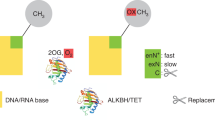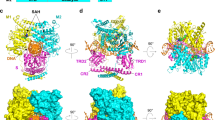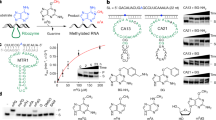Abstract
Nucleic acids undergo naturally occurring chemical modifications. Over 100 different modifications have been described and every position in the purine and pyrimidine bases can be modified; often the sugar is also modified1. Despite recent progress, the mechanism for the biosynthesis of most modifications is not fully understood, owing, in part, to the difficulty associated with reconstituting enzyme activity in vitro. Whereas some modifications can be efficiently formed with purified components, others may require more intricate pathways2. A model for modification interdependence, in which one modification is a prerequisite for another, potentially explains a major hindrance in reconstituting enzymatic activity in vitro3. This model was prompted by the earlier discovery of tRNA cytosine-to-uridine editing in eukaryotes, a reaction that has not been recapitulated in vitro and the mechanism of which remains unknown. Here we show that cytosine 32 in the anticodon loop of Trypanosoma brucei tRNAThr is methylated to 3-methylcytosine (m3C) as a pre-requisite for C-to-U deamination. Formation of m3C in vitro requires the presence of both the T. brucei m3C methyltransferase TRM140 and the deaminase ADAT2/3. Once formed, m3C is deaminated to 3-methyluridine (m3U) by the same set of enzymes. ADAT2/3 is a highly mutagenic enzyme4, but we also show that when co-expressed with the methyltransferase its mutagenicity is kept in check. This helps to explain how T. brucei escapes ‘wholesale deamination’5 of its genome while harbouring both enzymes in the nucleus. This observation has implications for the control of another mutagenic deaminase, human AID, and provides a rationale for its regulation.
This is a preview of subscription content, access via your institution
Access options
Access Nature and 54 other Nature Portfolio journals
Get Nature+, our best-value online-access subscription
$29.99 / 30 days
cancel any time
Subscribe to this journal
Receive 51 print issues and online access
$199.00 per year
only $3.90 per issue
Buy this article
- Purchase on Springer Link
- Instant access to full article PDF
Prices may be subject to local taxes which are calculated during checkout




Similar content being viewed by others
References
Machnicka, M. A. et al. MODOMICS: a database of RNA modification pathways--2013 update. Nucleic Acids Res. 41, D262–D267 (2013)
Helm, M. & Alfonzo, J. D. Posttranscriptional RNA Modifications: playing metabolic games in a cell’s chemical Legoland. Chem. Biol. 21, 174–185 (2014)
Crain, P. F. et al. Modification of the universally unmodified uridine-33 in a mitochondria-imported edited tRNA and the role of the anticodon arm structure on editing efficiency. RNA 8, 752–761 (2002)
Rubio, M. A. et al. An adenosine-to-inosine tRNA-editing enzyme that can perform C-to-U deamination of DNA. Proc. Natl Acad. Sci. USA 104, 7821–7826 (2007)
Carter, C. W. in Modification and Editing of RNA (eds Grosjean and Benne) 363–375 (ASM Press, 1998)
Randau, L. et al. A cytidine deaminase edits C to U in transfer RNAs in Archaea. Science 324, 657–659 (2009)
Gaston, K. W. et al. C to U editing at position 32 of the anticodon loop precedes tRNA 5′ leader removal in trypanosomatids. Nucleic Acids Res. 35, 6740–6749 (2007)
Jühling, F. et al. tRNAdb 2009: compilation of tRNA sequences and tRNA genes. Nucleic Acids Res. 37, D159–D162 (2009)
Spears, J. L., Gaston, K. W. & Alfonzo, J. D. Analysis of tRNA editing in native and synthetic substrates. Methods Mol. Biol. 718, 209–226 (2011)
Randerath, K., Chia, L. S., Gupta, R. C. & Randerath, E. Structural analysis of nonradioactive RNA by postlabeling: the primary structure of baker’s yeast tRNA Leu/CUA. Biochem. Biophys. Res. Commun. 63, 157–163 (1975)
Fleming, I. M. et al. A tRNA methyltransferase paralog is important for ribosome stability and cell division in Trypanosoma brucei. Sci. Rep. 6, 21438 (2016)
Ross, R., Cao, X., Yu, N. & Limbach, P. A. Sequence mapping of transfer RNA chemical modifications by liquid chromatography tandem mass spectrometry. Methods 107, 73–78 (2016)
Kapushoc, S. T., Alfonzo, J. D. & Simpson, L. Differential localization of nuclear-encoded tRNAs between the cytosol and mitochondrion in Leishmania tarentolae. RNA 8, 57–68 (2002)
Petersen-Mahrt, S. K., Harris, R. S. & Neuberger, M. S. AID mutates E. coli suggesting a DNA deamination mechanism for antibody diversification. Nature 418, 99–103 (2002)
Petersen-Mahrt, S. DNA deamination in immunity. Immunol. Rev. 203, 80–97 (2005)
Lonergan, K. M. & Gray, M. W. Editing of transfer RNAs in Acanthamoeba castellanii mitochondria. Science 259, 812–816 (1993)
Börner, G. V., Mörl, M., Janke, A. & Pääbo, S. RNA editing changes the identity of a mitochondrial tRNA in marsupials. EMBO J. 15, 5949–5957 (1996)
Mörl, M., Dörner, M. & Pääbo, S. C to U editing and modifications during the maturation of the mitochondrial tRNAAsp in marsupials. Nucleic Acids Res. 23, 3380–3384 (1995)
Alfonzo, J. D., Blanc, V., Estévez, A. M., Rubio, M. A. & Simpson, L. C to U editing of the anticodon of imported mitochondrial tRNATrp allows decoding of the UGA stop codon in Leishmania tarentolae. EMBO J. 18, 7056–7062 (1999)
Zhou, W., Karcher, D. & Bock, R. Identification of enzymes for adenosine-to-inosine editing and discovery of cytidine-to-uridine editing in nucleus-encoded transfer RNAs of Arabidopsis. Plant Physiol. 166, 1985–1997 (2014)
Rubio, M. A., Ragone, F. L., Gaston, K. W., Ibba, M. & Alfonzo, J. D. C to U editing stimulates A to I editing in the anticodon loop of a cytoplasmic threonyl tRNA in Trypanosoma brucei. J. Biol. Chem. 281, 115–120 (2006)
Teng, G. & Papavasiliou, F. N. Immunoglobulin somatic hypermutation. Annu. Rev. Genet. 41, 107–120 (2007)
Sample, P. J. et al. A common tRNA modification at an unusual location: the discovery of wyosine biosynthesis in mitochondria. Nucleic Acids Res. 43, 4262–4273 (2015)
Kapushoc, S. T., Alfonzo, J. D., Rubio, M. A. & Simpson, L. End processing precedes mitochondrial importation and editing of tRNAs in Leishmania tarentolae. J. Biol. Chem. 275, 37907–37914 (2000)
Acknowledgements
The research was funded by NIH grants GM084065 to J.D.A. and GM058843 to P.A.L. and a Czech Science Foundation (15-21450Y) grant to Z.P. We thank V. Gopalan, J. Rinehart and D. Schoenberg for comments and suggestions on the manuscript.
Author information
Authors and Affiliations
Contributions
All authors contributed to the design of the experiments and data interpretation; experiments were performed by M.A.T. (Figs 1a, b, e, 2a–c), Z.P. (Fig. 1c–d), K.W.G (Fig. 3a–i), K.M.M. (Fig. 4a–d), I.M.C.F. (Fig. 4e). The manuscript was written by J.D.A. All authors discussed the results and commented on the manuscript.
Corresponding author
Ethics declarations
Competing interests
The authors declare no competing financial interests.
Additional information
Reviewer Information Nature thanks J. Chaudhuri and the other anonymous reviewer(s) for their contribution to the peer review of this work.
Extended data figures and tables
Extended Data Figure 1 Anticodon sequences for tRNAThr from various organisms.
This limited set represents the few tRNAThr molecules for which modifications have been mapped to specific nucleotide positions as deposited in tRNAdb8. Highlighted in grey is position 32 of the anticodon, showing that this position is often modified to 3-methylcytosine (m3C).
Extended Data Figure 2 TRM140a methyltransferase is a nuclear enzyme.
a, Western blot analysis of total (T), nuclear (N) and cytoplasmic (C) fractions isolated from T. brucei as previously described24 probed with polyclonal antibodies raised against recombinant TRM140a. The same membrane was probed with antibodies against enolase, serving as a cytosolic marker and also as a control fraction to show the degree of nuclear contamination in our cytoplasmic fraction. b, Immunofluorescence localization of TRM140a using the same antibodies as in top panel of a. The cells were also stained with DAPI to establish the position of the nucleus (N) and mitochondrial (K) genomes for reference. ‘Merge’ refers to the superposition of the two panels, which confirms the nuclear localization of this protein. c, Primer extension analysis of total RNA isolated from the same fractions as above, primer +8 marks the positions of the strong stop one nucleotide short of position 32 (the methylated position), indicating that m3C is already present in the nuclear tRNA before cytoplasmic export. G, A, T and C refer to an unrelated sequencing ladder used as a size marker. T, N and C are as in a and O represents a mock primer extension with oligonucleotide primer alone but in the absence of template.
Extended Data Figure 3 Position 32 in the other tRNAThr isoacceptors is also methylated in the nucleus of T. brucei.
a, b, Similar reactions as in Extended Data Fig. 3c, but this time with oligonucleotide primers specific for tRNAThrCGU (a) and tRNAThrUGU (b), confirming that the strong stop in these tRNAs already appears in the nuclear fractions. This time, however, the expected product is at primer +7, as indicated.
Extended Data Figure 4 Concentration curves for the formation of m3C and m3U.
a, Concentration curve with increasing amounts of TRM140, ADAT2/3 was kept at the same molar ratio as the methyltransferase. The specific activities of TRM140 are as indicated and expressed in pmol per min per mg. b, Similar experiment as in a but this time showing the m3U activity of ADAT2/3 in the presence of stoichiometric amounts of the methyltransferase.
Supplementary information
Supplementary Figure 1
The file shows the uncropped western blots results from Figure 4. The relative electrophoretic migration of the size markers are shown by black lines on the left margin of each gel. The panels are representative of at least 5 independent experiments. TbADAT2, TbADAT3 (tagged version) and TbTRM140 have predicted molecular masses of 27, 39 and 47 kDa respectively. (PDF 7183 kb)
Rights and permissions
About this article
Cite this article
Rubio, M., Gaston, K., McKenney, K. et al. Editing and methylation at a single site by functionally interdependent activities. Nature 542, 494–497 (2017). https://doi.org/10.1038/nature21396
Received:
Accepted:
Published:
Issue Date:
DOI: https://doi.org/10.1038/nature21396
This article is cited by
-
Amphioxus adenosine-to-inosine tRNA-editing enzyme that can perform C-to-U and A-to-I deamination of DNA
Communications Biology (2023)
-
The RNA methyltransferase METTL8 installs m3C32 in mitochondrial tRNAsThr/Ser(UCN) to optimise tRNA structure and mitochondrial translation
Nature Communications (2022)
-
Sequential action of a tRNA base editor in conversion of cytidine to pseudouridine
Nature Communications (2022)
-
Structural basis for sequence-independent substrate selection by eukaryotic wobble base tRNA deaminase ADAT2/3
Nature Communications (2022)
-
Synthesis of N4-acetylated 3-methylcytidine phosphoramidites for RNA solid-phase synthesis
Monatshefte für Chemie - Chemical Monthly (2022)
Comments
By submitting a comment you agree to abide by our Terms and Community Guidelines. If you find something abusive or that does not comply with our terms or guidelines please flag it as inappropriate.



